Common mallows are annual plants, and sometimes it seems they can be found anywhere, while on other days, they’re nowhere to be found. The common mallow is most visible when it develops flowers in a stunning lilac color. Besides being known by this name, common mallows are also called cheese weed since the leaves resemble cheese wheels.
Common mallows are part of the large family of Malvaceae plants that include cotton, okra, and hibiscus.
Common mallows are edible plants that start to grow in the spring. They develop flowers in late spring/early summer, while flowers become visible during the summer. After the flowering has passed, the plant develops seeds in a small, crinkly, round-shaped sack.
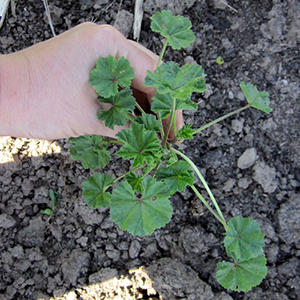
Growing common mallows from seed is easy, and once you establish the plant, it is easy to maintain. It simply grows in almost any soil and does not require any special treatment.
Regarding the common mallow’s appearance, the plant has a deep taproot and low spreading branches that reach from a few inches up to 25 inches long.
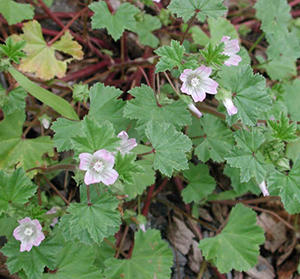
The most common color of the flowers is lilac with fuchsia lines, but they also come in white or pinkish.
The leaves of common mallows are alternate, on long petioles, circular to kidney-shaped, toothed and shallowly 5–9 lobed, and 2–6 cm wide. Short hairs present on upper and lower leaf surfaces, margins, and petioles.
When it comes to eating common mallows, all parts of the plant are edible. The leaves can be used in salads in fresh form, and you can even use the flowers in the same way. Besides being used in salads, the leaves are great to add to soups or to make mallow fritters.
As stated above, the best way to use them is fresh in salads. Here is a simple recipe with an amazing flavor.
You will need the following:
- 1 ½ bunch common mallows, washed and drained
- 2 tomatoes, chopped
- 1 cucumber, sliced
- 2 oz. feta cheese, chopped
- 1 handful chopped almonds
- 2 dried mini chili peppers, crushed, or 1 chili pepper, seeded and chopped (optional)
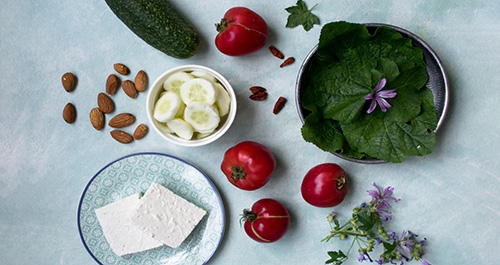
Vinaigrette:
- 3 tablespoons extra virgin olive oil
- 2–3 tablespoons lemon juice
- Salt, to taste
Instructions (makes 3–4 servings):
#1. Combine the common mallows’ leaves in a bowl with tomatoes, cucumbers, feta, almonds, and chili peppers.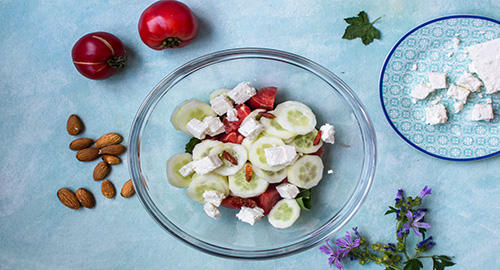 #2. Pour the olive oil and lemon juice vinaigrette over it, and season to taste with salt.
#2. Pour the olive oil and lemon juice vinaigrette over it, and season to taste with salt.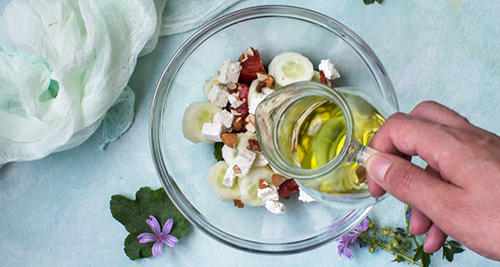 #3. Stir gently and serve, garnished with some common mallow flowers.
#3. Stir gently and serve, garnished with some common mallow flowers.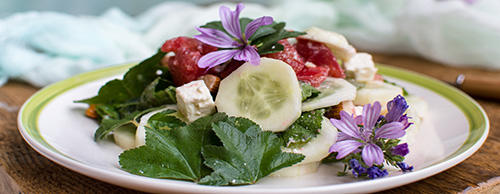
Related: The 5 Most Common Edible Weeds In Your State
If you want you can make more of a hearty dish using mallows. You only need ½ Tb Olive oil, 2 cups of mallows (roughly chopped), one small onion and salt and paper to taste. First heat a skillet on medium heat, add olive oil. Afterwards, add the onion, and saute for 2-3 minutes. Add the leaves and the salt and pepper. Add a squeeze of lemon, and serve immediately.
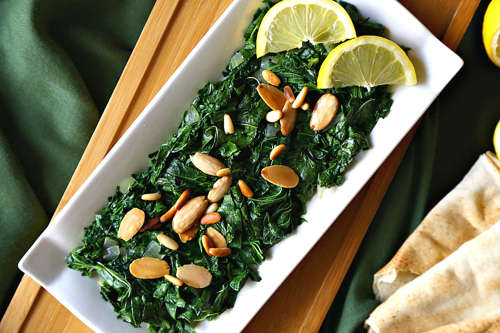
The Benefits of Eating Common Mallows
Common mallows are highly nutritious and contain significant levels of vitamins A, B, C, and E; inulin; phenols; flavonoids; essential fatty acids; fiber; calcium; magnesium; selenium; and potassium. It also boosts the immune system by preventing bacterial infections and other foreign agents to affect wounded areas.
Pregnant women or new mothers may like to know that mallow leaves can provide useful amounts of iron as well as being quite high in zinc and most vitamins.
You can also use it as a pain reliever, particularly in topical applications. If you have been wounded or injured, you can apply the leaves in the form of a poultice to the affected area. The leaves help to speed healing, due to their rich vitamin content, but will also offer certain analgesic properties to the area, reducing pain and discomfort. The poultice can also be used for insect bites, bruises, sunburn, or rashes, it can be very effective for reducing inflammation and swelling.
You may also like:
 How to Make Dandelion Bread (With Pictures)
How to Make Dandelion Bread (With Pictures)
10 Things Cowboys Carried With Them in the Wild West to Survive (Video)
When Grocery Stores Go Empty; A Back Door Shopping Strategy

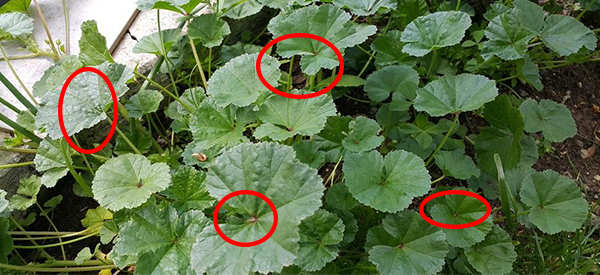













Be sure to identify any mallow from marshy areas, “marsh mallows,” are contraindicated for their high sugar content.
lol
Ohhhhh, that is bad.
It’s all about branding. So many jokes out there, my branding is corny jokes. Gotta’ have a niche. Me? I left my Yuma in Arizona.
I figured that the marsh mallow comment was coming, but it tickled me that it was the very first comment. 🙂
There really is a marsh mallow plant, also called common mallow. I was just admiring its big white flowers on a camping trip in Oklahoma. Was the original source of the marshmallow. Like sassafras for root beer or Smilax root for its cousin, Sarsaparilla. Or you can use Yaupon leaves for a tea that is higher in caffeine than coffee. Pine leaf tea for scurvy still bothers me, must taste pretty bad.
Actually IvyMike pine leaf tea isn’t as bad as you might think. Read my June 24th article below. I drank gallons of it over that 10 months.
By the the patches here in one are are full of common mallow. Sort of a blue/purple colored flower. Walking on it doesn’t deter its growth at all. I haven’t tried it cooked but I do enjoy it in a salad.
pine needles taste kind of citrusy with a little bit of resin texture use fresh new needles if you dont want that.
How I Survived Alone for 10 Months Living Off the Land
Yep, but our own Clergylady. Awesome.
By Mary CalderJune 24, 2019 10:31
https://www.askaprepper.com/how-i-survived-alone-for-10-months-living-off-the-land/
for a second i thought you were serious
jeez that was an eye roller
Someone commented, great comment. I can’t find it, so I will repeat it here:
“Comment:
There really is a marsh mallow plant, also called common mallow. I was just admiring its big white flowers on a camping trip in Oklahoma. Was the original source of the marshmallow. Like sassafras for root beer or Smilax root for its cousin, Sarsaparilla. Or you can use Yaupon leaves for a tea that is higher in caffeine than coffee. Pine leaf tea for scurvy still bothers me, must taste pretty bad.”
I have never made pine needle tea but have always figured it probably tastes something like retsina, a favorite drink of the Greeks which has a flavor somewhere in the vicinity of what I think turpentine would taste like or pine needle tea with a healthy shot of vodka.
Having tasted retsina I can now say, “Okay. Been there; done that; don’t need to do it again.”
Faintly turpentine but far more pleasant.
I have not tried it, but it is probably much like other evergreen teas and beers in that the really bad tasting lighter aromatics boil off leaving just the more subtle flavors.
I was watching a video where this was the case regarding making an evergreen beer that was popular back before, and during the war of northern aggression.
Was that an aggressive Northern beer or a righteous Southern brew?
But they are said to be fat-free on no fat.
Just saying that the mallow is sometimes called cheese wheel plant because of the shape of the seed capsule not the kidney-shape leaves.
Ironic that these ring my garden and I’ve been ripping them out. Glad to know I can use them besides feeding my goats the weeds 🙂
we have mallows here except they are perinnals, have very long roots and very difficult to kill with weed spray of any kind. They have white flowers, and the same seed pod as these. looks exactly like the one in your photo.
I have a patch of common mallow along the path between some buildings. Just a small area they have kept themselves to over the time I’ve owned this land. We eat some and end up walking on some. They are tough, as being walked on doesn’t deture them at all. Chopped off to bare ground they still come back. Zero care and they thrive. When mosquitoes are frequent along the neighbors small irrigation ditch, the area where we walk on the Mallows never has mosquitoes. The plants are green and presenting edible leaves much of the year. I don’t see much of them from late January to mid February or early March. I guess they aren’t fond of below zero nights.
These grow right in a path. Walking on them doesn’t deter them. Bruised leaves seem to keep mosquitoes away from that area.
I pick and wash leaves now and then to throw in salads. We like them in a mixed salad with lots of different I gradients. .